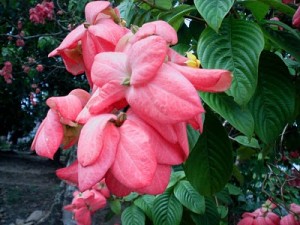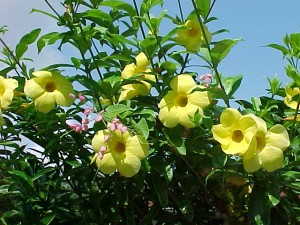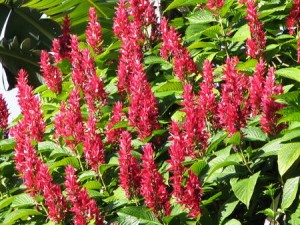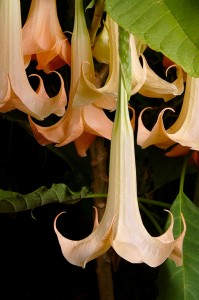Tropical Flowering Shrubs – A Color Extravaganza
By Donna Porter
With all of the boldly exotic-looking tropical beauties that we have to choose from to use in our gardens and landscapes, like Helcionias, Gingers, Aroids, Marantas and Crotons, we sometimes forget that we also have a fabulous selection of flowering tropical shrubs that add even more color, form, grace and pizzazz to our world and for our eyes to behold. Unlike their aforementioned garden companions, flowering shrubs perform nearly year round and add a rainbow of color and flower form to your garden or landscape. Below are just a handful of what I believe are some of the most noteworthy of the most commonly seen in our area and in a nice assortment of colors. Remember also that most flowering shrubs give their best performance when sited in a location where they receive at least 6 hours of full sun.

The eye-catching Mussaenda sp. (Mussaenda in Spanish also) hails from tropical Asia, Africa and the South Pacific Islands. Typically, we see the vibrant pink varieties, which exhibit an exquisite profusion of pink, petal-shaped “flowers”, (photo) but the showy part is not the flower but the flower’s sepal, (not the bract) which is part of the calyx, present at the base of all flowers. The pink Mussaenda are hybrids, but the names of those sold here are unbeknownst to me. Mussaenda philippica ‘Dona Aurore’ is the refreshingly-white variety, which is a ravishing beauty with clusters of white sepals. This is an awesome variety to behold since white flowers are not that common on tropical plants. I have only recently seen an orange variety of Mussaenda and Mussaenda erythrophylla/Ashanti Blood is a vibrant red species (just not as prolific in sepal production as the pinks) which has the appearance of a poinsettia, but contrary to popular belief, Mussaendas belong to the family Rubiaceae and are not related to the poinsettia.

To add splashes of bright yellow to your garden, Allamanda cathartica/Allamanda/Jalapa in Spanish, exhibits 3-5” trumpet-shaped, bright yellow flowers. The natural growth habit of A. cathartica is that of a climber, therefore it is best suited to be trained on a fence or trellis or planted where it will cascade over a wall. This probably explains why they always look so gnarly when placed in a landscape, and expected to behave and grow upright like all the other shrubs. Allamanda schotti is very similar to A. cathartica, but is a much smaller, compact species that is more manageable in a small garden, planter or pot. Although not always detrimental, stem blight is a common malady on A. schotti and causes the tips of the stems to dieback. Another small, yellow dazzler is Pachystachys lutea/Golden Shrimp Plant/Camarones in Spanish. It erectly displays conical-shaped yellow bracts (photo) from which white, shrimp-like flowers emerge. It is Native to Peru and likes sun to bright shade. With routine, light pruning this shrub can be easily maintained to a very nice, compact size of 2 ft. that is continuously in bloom.

If you desire a large shrub, perhaps for screening or backdrop, with large red flower clusters, then Megakepasma erythrochlamys /Red Cloak/Pavoncillo Rojo in Spanish would be a great choice. It originates in Venezuela and can reach heights of 12’. The showy “flowers” are a huge cluster of bracts which can grow to one foot in length. Another red-flowering shrub you may consider for your garden collection (especially if you want to impress your northern friends visiting at Christmas) is Euphorbia pulcherrima/ Poinsettia /Pastora in Spanish. The poinsettia (title photo) belongs to the family Euphorbiaceae and is native to Mexico, where in the wild it can grow to 15’. After the holidays are over, re-pot or transplant your poinsettia out in your garden in full sun and in very-well drained soil and cut back every 3 months to encourage branching. Holiday poinsettias are hybrids grown from cuttings in climate- controlled greenhouses. Fourteen hours of darkness is needed to initiate bloom, but even being on the border of this day length requirement they will naturally begin to bloom here around October.

For a surprising bloom of various shades of blues, violets, purples, lavender and white, nothing can beat the bountiful, mixed profusion of Brunfelsia grandiflora/ Yesterday-Today-Tomorrow /Ayer-Hoy-Manana, which hails from Columbia to Bolivia. This is not one for the potted plant collection, as it can grow to 12’ in height. But, its unusual combination of colors and shades of color (photo) on the same plant is a rarity in the shrub world and can be a true show- stopper when in bloom.
If you are searching for a flowering shrub some variation of the color orange, then the all so common, but magnificent, Ixora cadei/Giant Ixora/Ixora in Spanish, with its naturally rounded shape, is a good selection. Even more challenging to find here are dwarf shrubs, and the hybrid Ixoras shine bright in this category, offering selections that grow to a height of only 2 ft… They also come in light yellow and a subtle pink. If a soft peach color is preferred,

Brugmansia versicolor/Angel’s Trumpet/Reina del la Noche with its long 12-20” awe-striking, pendant and funnel-shaped peach flowers (photo) will fill your nights with fragrance and sweet, sweet dreams.
So, even though we foreigners tend to go ga-ga over the more “exotic” looking tropical flowers, tropical flowering shrubs will reward you with a parade of color nearly year-round.
Pruning workshops for gardeners, or interested home owners, will be just one of many classes that will be on the educational program menu at the future botanical garden, where the endless assortment of flowering shrubs will paint the grounds with every color of the rainbow….and then some.
Donna is a Horticulturist and has been living and working in Manuel Antonio for 8 years. She consults, designs, installs and maintains gardens for private homes and hotels and also develops botanical trails. Donna is the founder and first Director of the Botanical Garden of the Ozarks and is pursuing the development of a botanical garden in, and for, the Quepos area. dpdreamer@yahoo.com, 2777-5149


